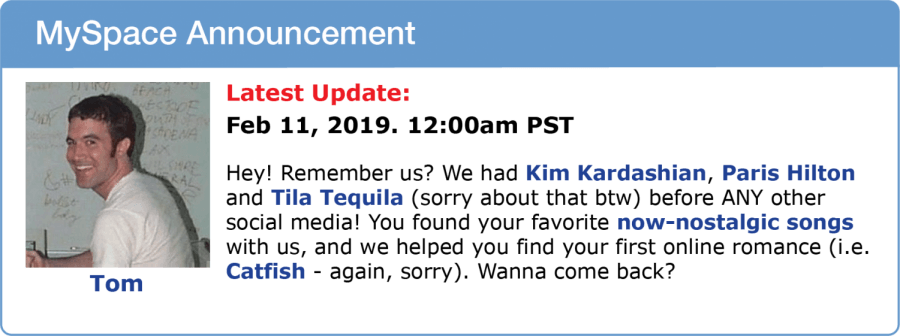Annalisa Baranowski | The DePaulia
From Top 8s to mutuals; MySpace’s forgotten influence on how we interact with the internet
February 11, 2019
Despite what you may think, MySpace still exists. The social networking site, which reigned popular in the mid-to- late-2000s, was purchased by the media conglomerate Meredith Corporation in late January of 2018 (two years after being purchased by Time Inc.). While the site may not be as popular as it once was, its influence can still be felt in 2019 through our celebrity obsession, today’s social media networks and music discovery.
MySpace was founded in 2003, serving as a platform that carried over the most popular aspects of Friendster while adding more multimedia elements. It quickly became successful, and by 2005 the site was so big that Facebook founder Mark Zuckerberg offered to buy it for $75 million. By 2006 there were over one million accounts, and by 2007 MySpace was valued at $12 billion.
By 2008, however, Facebook began to overtake MySpace in web traffic rankings. As time passed, Twitter, Instagram and Zuckerberg’s Facebook soared in popularity while the user base on MySpace shrank smaller and smaller, to a point where it was not much more than a joke. But in its time as a prominent social networking site, MySpace left a significant and lasting influence on our culture.
For one, MySpace helped birth a new crop of celebrity: the Internet Celebrity. People like Paris Hilton and Tila Tequila soared to popularity through their MySpace presence. Some, like Kim Kardashian and Kendall and Kylie Jenner, still have their profile pages up and accessible. These high-profile users gave others a reason to constantly check the website and keep up with their feeds, just like most of the social media networks today. According to Paul Booth, an associate professor of media and cinema studies and digital communication and media arts, the celebrity presence on MySpace allowed “everyday people [to] feel closer to celebrities” and feel like “they’re just like us.” This aspect of MySpace moved the perception of social networking – and the internet as a whole — to something new.
“I do think MySpace influenced the way we conceive of being online — instead of simply going online like it’s a repository of information [a giant electronic library], MySpace showed that you could go online to just hang out,” Booth said. “That was an important move in the history of the web and it led to a lot of of new social interactions.”
Karoline Bacewicz, a 21-year-old student, calls MySpace her “entire middle school experience.” She describes the site as something that stood out on its own as a site that “was more about expressing yourself through the profile you have along with what you post” and “entirely centered around aesthetic and presentation.”
MySpace wasn’t only a place for sharing details about your friends and lives; it was a space for users to share and discover their favorite music. Just as users could show off their top friends on their profile, they could do the same with their top artists. Artists like Katy Perry, Arctic Monkeys, Vampire Weekend and Sean Kingston found fame through the website. Some artists that eventually became stars (like Lana Del Rey, who published under her real name Lizzy Grant) got their start uploading songs to MySpace. These artists were able to share songs that were able to accessed immediately by their fans, building a more intimate connection than fans would get from simply purchasing a CD at a store.
Reasons like this helped the site appeal to music fans, so much so that Pitchfork recently published a video asking if it was “music’s best social media platform.”
I do think MySpace influenced the way we conceive being online instead of simply going online like it’s repository of information, [a giant electronic library], MySpace showed that you could go online just to hang out.
— Paul Booth, Professor of Media & Cinema Studies
Judy Berman, the Pitchfork contributor behind that video, compares MySpace to Bandcamp as a way to learn more about an artist you just heard about. MySpace had a community feel to it as well — Berman said the site “empowered fan communities to organize and make their voices heard on a large scale, in the same way that you now see followers of Beyonce or Nicki Minaj or BTS rallying on Twitter.”
Part of that community feeling of MySpace had to do with discovering music through real people. In today’s digital age, streaming sites like Spotify still give users recommendations, but they come in endless playlists created by algorithms; it lacks the human touch that was present on MySpace. Berman cites friends and colleagues, music and culture publications like Pitchfork, and sites like Bandcamp and Soundcloud
as places she discovers new music now (avoiding Spotify recommendations because “discovering new music through algorithms creeps [her] out”).
Ty Yamamoto, a 20-year-old student, seconds the desire for discovering new music through other people. He tends to prefer discovering music “mostly through word of mouth and various music- oriented publications.”
Of course, the time removed from MySpace’s glory days could have us looking back with rose-tinted glasses. Maybe MySpace would have fallen ill to harassment problems like those that plague Twitter. Maybe our friend Tom From MySpace would have to give testimony in front of the US Congress just like Mark Zuckerberg did. If MySpace were to start up again and gain back a large user base, it probably wouldn’t be as fun as we remembered. But that’s okay. For now, we’ll always remember MySpace, like Bacewicz calls it, as “the forgotten alternative culture social media platform.”
